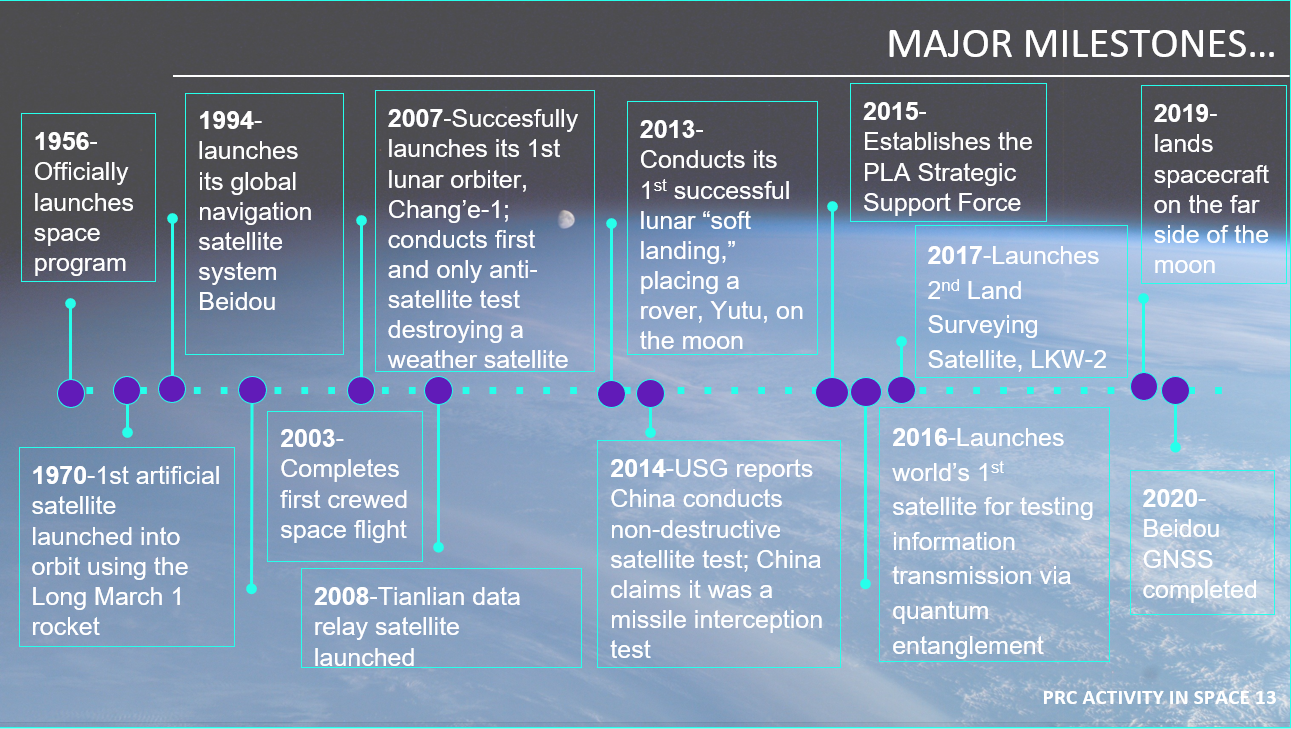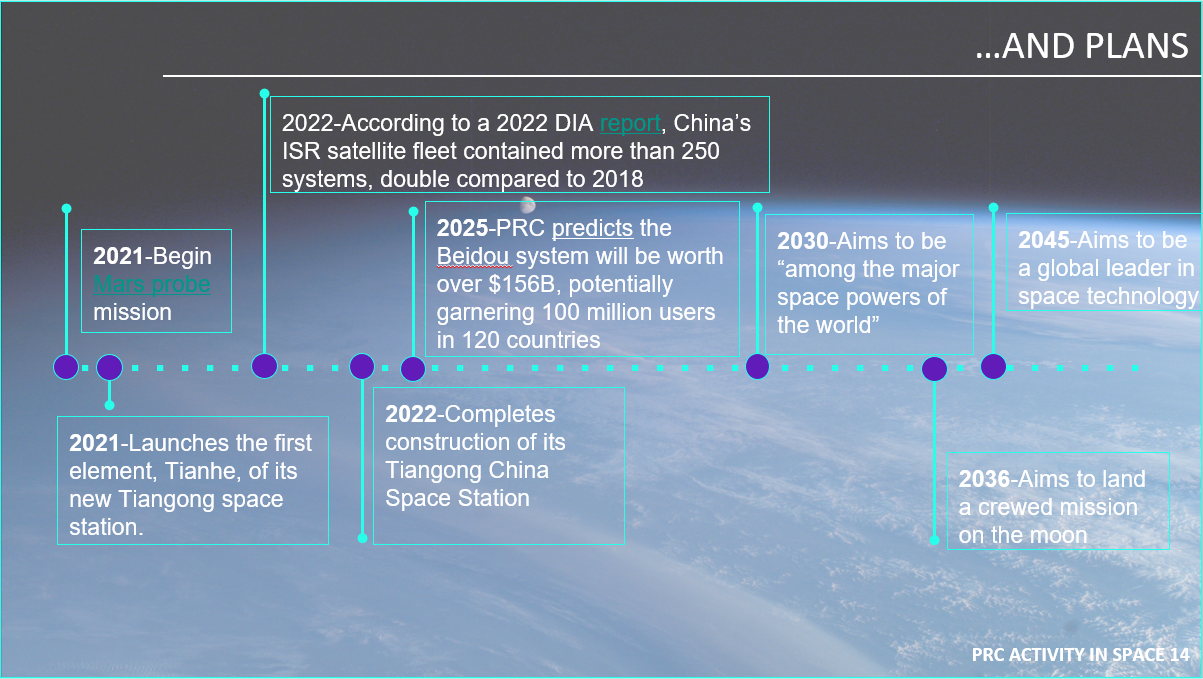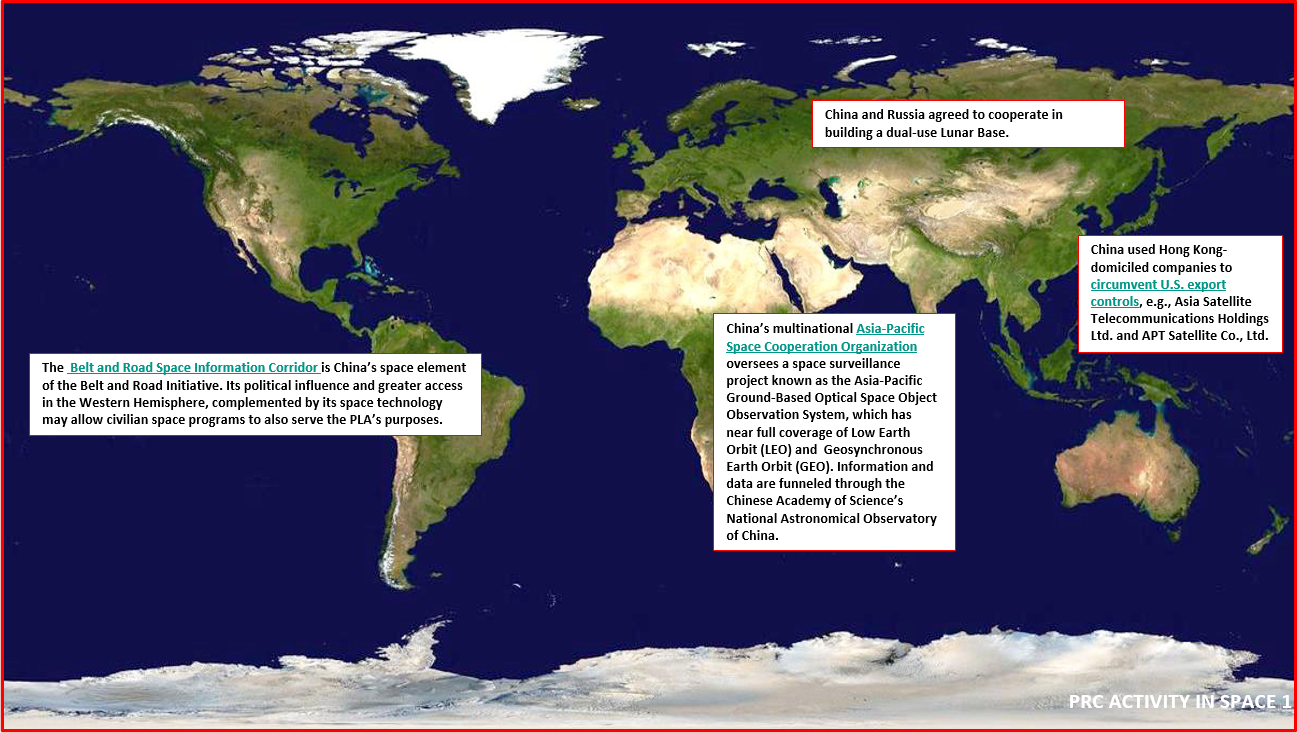China’s Objectives in Space:
China’s space program is rapidly maturing in support of its ability to develop power projection and expeditionary capabilities. Its 2013 Science of Military Strategy anticipates future wars will begin in space and cyberspace, arguing that “seizing command of space and network dominance will become crucial for obtaining comprehensive superiority on the battlefield and conquering an enemy.”
Dual-use. China’s military, the People’s Liberation Army (PLA), oversees both military and civilian space activities. National strategies such as Military-Civil Fusion facilitate the PLA leveraging civilian and commercial space research and development and other resources for military applications.
Financial and Political Resourcing. China has been able to invest significant resources into its space programs and make swift progress in achieving its goals because it’s a priority for China’s top leaders, its political system enables the development and execution of long-term plans, its Military-Civil Fusion strategy, and China leverages foreign technologies and expertise through its international commercial cooperative agreements.
China’s defense spending is intentionally opaque. This is further complicated by the dual-use nature of the sector, and because China’s civilian and military space programs are blended.
- An April 2019 U.S.-China Economic and Security Review Commission staff report referenced earlier estimates on China’s space spending, since there is a lack of transparent and updated data: “The Organization for Economic Cooperation and Development estimated China’s combined military and civil space budget in 2005 was $1.5 billion in purchasing power parity, the fourth-largest of any single country, compared to the U.S. space budget that year of $36.6 billion, the largest. China’s budget increased to $6.1 billion and $10.8 billion in 2009 and 2013, respectively, the world’s second largest in those years, after the U.S. budgets of $43.6 billion and $39.3 billion. Beijing does not release accurate cost data on military goods and services, so purchasing power parity conversions are not entirely reliable, however.”
China’s Strategic Threat to U.S. Space Security:
Space has emerged as a central arena of great power competition. China’s intent in space is to reduce U.S. and allied military effectiveness in the event of a future military confrontation.
•The PLA views cyberspace, space and electronic warfare as inherently intertwined. Management of these three strategic areas fall under the PLA’s Strategic Support Force.
•According to a 2022 DIA report, the PRC is using its intelligence, surveillance, and reconnaissance (ISR) satellite fleet “for military and civilian remote sensing and mapping, terrestrial and maritime surveillance, and intelligence collection. China’s ISR satellites are capable of providing electro-optical and synthetic aperture radar (SAR) imagery as well as electronic and signals intelligence data.”
•Since a 2019 DIA assessment and a Project 2049 Institute report indicating China was likely testing on-orbit dual-use technologies for counterspace missions, a 2020 DoD report confirms the PRC was developing anti-satellite (ASAT) missiles for use against satellites in geosynchronous Earth orbit.
China’s International Space Programs:
“Outer space is a critical domain in international strategic competition. Outer space security provides strategic assurance for national and social development.” – China’s National Defense in the New Era, July 2019
Chinese commercial space companies sell space-related technology and services to a number of countries. Between 2007 and 2018, China launched 20 satellites for 13 countries (Algeria, Argentina, Belarus, Bolivia, France, Indonesia, Laos, Nigeria, Pakistan, Saudi Arabia, Sri Lanka, Thailand, and Venezuela).
In 2022, China claimed it had signed 149 space cooperation agreements or memorandums of understanding, with 46 national space agencies and 4 international organizations
In 2019, the China Manned Space Agency and the UN Office for Outer Space Affairs announced plans to conduct at least six scientific projects in cooperation with 17 countries aboard the planned China Space Station.
China’s International Space Programs (Cont’d):
China established the Asia-Pacific Space Cooperation Organization in 2008 to enable facilitated cooperation in areas such as data sharing, ground system interconnectivity, disaster monitoring, ground-based space object observation, and education and training.
China has overseas space tracking stations in six countries: Australia, Chile, Kenya, Namibia, Pakistan, and Sweden.
China also operates a large satellite and space mission control center in Argentina that supports its civilian space endeavors, including satellite tracking of U.S. military satellite positioning and activity.
Space agencies for Russia and China agreed to build a joint research base on the moon with an agreement pending. This Lunar Base will serve dual-use functions, monitoring deep space and enhancing remote sensing of Earth.
China’s International Space Programs (Cont’d):
China participates in international space governance bodies such as the UN Committee on the Peaceful Uses of Outer Space and the UN Office for Outer Space Affairs. China and Russia have championed iterations of a widely-supported UN resolution on the Prevention of an Arms Race in Outer Space (PAROS), which lacks verification capabilities and omits restrictions on anti-satellite weapons, the absence of which leaves countries’ behavior in space unchecked.
Russia and China offered a draft “Treaty on the Prevention of Placement of Weapons in Outer Space,” an instrument that does not include terrestrially-based anti-satellite weaponry which both Russia and China have long since developed and deployed.
The Partial Test Ban Treaty, with 104 signatory nations including the U.S. and Russia, prohibits testing and use of nuclear weapons in space. China, France and North Korea are among the remaining countries that have not signed. Of note, the Treaty does not prevent the testing and use of non-nuclear weapons in space.
China’s International Space Programs (Cont’d):
U.S. law places limitations on civil space cooperation with China, including through a near-complete embargo on the export of commercial, dual-use, and military technologies with applications in space, and other end-user restrictions. Nevertheless, Chinese companies reportedly have exploited loopholes in existing laws and export control regulations to access U.S. space technology via complex subsidiary investments in U.S. companies.
U.S. allies with less restrictive export controls are more willing to trade goods and services from Chinese commercial space companies, strengthening China’s indigenous capabilities.
The U.S. Space Force Acquisition Council, created under the FY 2020 National Defense Authorization Act, handles procurement operations for disparate DoD space entities. In April 2020, the Council convened an emergency session to prevent fragile supply chains, at-risk workforces and receding commercial markets from being acquired by Chinese commercial space companies.
China’s Belt and Road Space Information Corridor:
The Chinese government has highlighted space cooperation as a component of China’s Belt and Road Initiative (BRI), and refers to these projects as the “Space Silk Road” or “BRI Space Information Corridor.”
•China’s Ministry of Industry and Information Technology sells the Information Silk Road, to include the Beidou (BDS) Global Navigation Satellite System (GNSS) and 5G networks, to global audiences as a completely self-sufficient technology infrastructure that anticipates life in the 21st century. (Beidou translates to “Big Dipper”)
•China’s Space Silk Road connects Eurasia and Africa with BDS, providing China and its BRI partners with global positioning, navigation and tracking for both civil and military purposes.
•By embedding BDS and serving as the GNSS provider globally, the PRC can influence third countries and control shares in the satellite navigation industry and service markets upon which third countries rely.
China’s Belt and Road Space Information Corridor (Cont’d):
“BDS should provide “all-time, all-weather and high-accuracy positioning, navigation and timing services to global users.” – PRC White Paper: China’s Beidou Navigation Satellite System, June 2016
BDS Generation 1 was started in 1994 and became operational in 2000, offering commercial use in China and neighboring regions
BDS Generation 2/COMPASS was started in 2004 and became operational in 2011, offering commercial use across the Asia-Pacific region
BDS Generation 3 was started in 2009, became operational in 2020
- The PLA’s Beidou GNSS program provides an indigenous positioning, navigation, and timing system and is an alternative to the U.S. Global Positioning System. China promotes BDS as a “civilian-led program intended primarily for commercial and scientific purposes.”

Timeline of Major Milestones in China’s Space Influence Campaign:

Timeline of Plans in China’s Space Influence Campaign:

Additional sources:
·U.S.-China Economic and Security Review Commission, 2021 Annual Report to Congress, November 2021.
·Defense Intelligence Agency, 2022 Challenges to Security in Space report, April 2022.
·Todd Harrison, “International Perspectives on Space,” Center for Strategic and International Studies, May 2020.
·U.S.-China Economic and Security Review Commission, China’s Ambitions in Space: Contesting the Final Frontier (chapter in 2019 Annual Report to Congress), November 2019.
·National Bureau of Asian Research, The Space and Cyberspace Components of the Belt and Road Initiative (chapter in Securing the Belt and Road Initiative: China’s Evolving Military Engagement Along the Silk Roads), September 2019.
·University of California Institute for Global Conflict and Cooperation, China Dream, Space Dream: China’s Progress in Space Technologies and Implications for the United States, March 2015.
·U.S. Department of Defense, Defense Space Strategy, June 2020.
·”The Beidou Satellite Network and the ‘Space Silk Road’ in Eurasia,” Jamestown Foundation China Brief, July 2020, https://jamestown.org/program/the-beidou-satellite-network-and-the-space-silk-road-in-eurasia/?mc_cid=3629b3ce05&mc_eid=5debcfd568
*Last Updated: 11/14/2022
###
